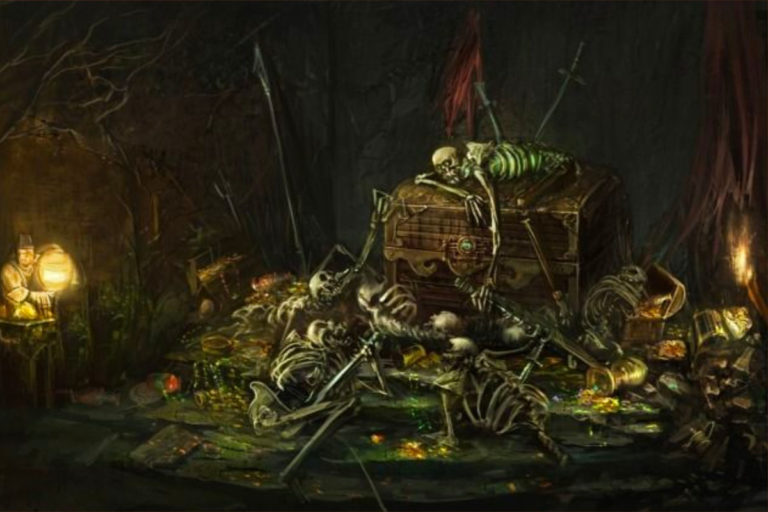Index Card RPG is infamous for its loot. It can drive gameplay or character progress, and the loot tables at the back of the books are just sublime. But how do you categorize it all? You’ve got the different roll tables, like EPIC, MAGIC, or SHABBY, but those categories are really broad. Wouldn’t it be beneficial if things were a little tighter?
I think so, and I have really benefitted from taking a more granular approach to grouping loot together. Specifically, through the use of Tags.
Now, Tags were something that was prominent in earlier editions of Index Card RPG but was kind of left out in Master Edition. You still see traces of them but overall they were deemed useful, just not necessary to make the game work. That said, let me show how useful they can be.

Establishing Simple Tags
The first thing you need to do is establish some simple Tags that you can remember. Part of why Tags are so useful is that they are keywords that connect large concepts to simple words. In ICRPG CORE (p. 19), a few Tags for loot, like FOOD, GEAR, SPELLS, and POWERS, were already included. But what other Tags could you include?
For me, I break down my loot types with these 10 Tags:
- AMMO
- ARMOR
- FOOD
- ITEM
- MAGIC
- NPC
- SPELL
- TOOL
- TREASURE
- WEAPON
A lot of these types should already sound familiar to you and that’s on purpose. When you have simple Tags you can quickly come up to speed with how they work, what’s involved, or how they might play into the game. This is especially helpful with players. Once you have Tags clearly established and used consistently, players pick up on them very quickly. If I say they find a piece of TREASURE loot, that keyword is going to clue them in immediately, without much explanation.
Now a word of caution before I define each of these Tags. Don’t go overboard with your Tags. You want to have enough to cover your bases, but not so many that they don’t come up fairly regularly. You want them to be a consistent part of your game. Not an obscure occurrence.
Different Types of Loot Tags
So what exactly do I mean when I say something is TREASURE loot? Or NPC loot? Well, this is another benefit of having these Tags defined. Let me walk you through it.

| TAG | Definition |
|---|---|
| AMMO | AMMO includes anything that fuels or charges another item. There is usually a limited amount when found so I make sure to include a number of users or an amount to roll. |
| ARMOR | ARMOR includes anything that boosts DEFENSE or absorbs damage. |
| FOOD | FOOD is anything that is consumed and has a limited number of uses. FOOD is a free action to consume or share unless a player is DYING. For me, players need to be stabilized before consuming. |
| ITEM | ITEMS include anything that has a limited number of uses. It may sound general, but it queues players in that they should consider carefully when they want to use it. |
| MAGIC | MAGIC includes things that are magical. They might do MAGIC effort or contain some kind of effect that the wielder can activate like a spell. MAGIC items also tend to be rule breakers. |
| NPC | NPC loot includes actual Non-Player Characters. They are companions, allies, and friends of the party that travel with them. I treat them like loot because they can be activated by players for special abilities, in place of their own turn. They also can be targeted by enemies so they also include some kind of HP or HEART count that players might want to keep track of. |
| SPELL | SPELLS, either WIS or INT, are loot that enable players to cast a spell. If it’s an INT spell, it would be an item like a scroll or a book. If it’s a WIS spell, they don’t take any inventory and players just learn them permanently. |
| TOOL | TOOLS include anything that is primarily utilitarian and designed for specific tasks. It usually requires an action to activate or makes certain checks easier. |
| TREASURE | TREASURE includes anything that doesn’t really have any benefit other than being valuable. It could be monetarily valuable and just fills inventory slots, or it could have narrative value. |
| WEAPON | WEAPONS include anything that’s primary purpose is to damage an enemy. There is usually some kind of range involved as well, whether that’s CLOSE, NEAR, or even FAR. It could deal any type of effort and may be susceptible to certain disadvantages on a Nat 1, like a gun jamming or sword breaking. |
From here, I’ve pretty much covered my bases and connected the larger concepts that I want to be consistent on with the specific keywords. Additionally, I now have a large enough variation that I don’t always have to be dropping WEAPONS into my games. I can put FOOD, TREASURE, TOOLS, or even NPCs as Treats within the different scenes and still be handing out lots and lots of loot.
Vampire’s Crypt Roll Table Example
As an example, let’s imagine a D12 roll table for a Vampire’s Crypt, and see how these different types can help make a more exciting collection of loot.

| Roll | Loot | Description |
|---|---|---|
| 1 | Abram Kenway | NPC, ❤️ Werewolf, Frenzied Claw: 2D6 damage to a NEAR target |
| 2 | Pickled Garlic | FOOD, 4 Uses, Sealed jar of potent garlic, repel CLOSE vampires for D4 Rounds |
| 3 | Ancient Gold | TREASURE, a bag of gold coins from a long-forgotten civilization |
| 4 | Blood Signet | MAGIC, Seal your blood to a single ally and share your pool of health |
| 5 | Blessed Lockpicks | TOOL, Blessed by a priest, locks seal by MAGIC are EASY to unlock |
| 6 | Werewolf Cloak | ARMOR, +1 DEF, Made from the hides of slain werewolves, reduce CLOSE melee damage taken by 2 |
| 7 | Preserved Blood | FOOD, 3 uses, Can sustain a vampire for weeks, regain 1 HP with each use |
| 8 | Black Fog | WIS Spell, Fill a NEAR area with dense fog for D4 Rounds. All saves are HARD |
| 9 | Shadow Cloak | ARMOR, a cloak sewn from moonlight; MAGIC damage taken is halved at night |
| 10 | Morwenna’s Necklace | MAGIC, An ancient, ornate amulet that grants immunity to vampiric charm and mind control |
| 11 | Silver-Tipped Arrows | AMMO, 6 Uses, Deal ULTIMATE against undead creatures; cannot be retrieved |
| 12 | Vampire’s Rapier | WEAPON, When attacking, always roll against a TARGET of 10 |
Not only does that look like a fun and varied table, it was actually pretty easy to fill. What I did was drop in the type of loot I wanted into each row and it immediately brought it into focus. I knew that a FOOD item would have a couple of uses so let’s think of something that may be beneficial several times. ARMOR would give some kind of DEF boost and reduce damage in some way and so on.
I could also very quickly see that the table wasn’t loaded with one or two types, or maybe I would have wanted that. I could have put 10 out of the 12 options as TREASURE if this had been a vault instead of a crypt. It all works.
The idea of using Tags as part of my loot design has really helped my game. It keeps me organized and consistent. I also consider it a player aid where we can very easily communicate using plain language, which is such a strength of Index Card RPG.
It’s also not game-changing, in that I’m bound by these types and categories. They’re purposefully designed to be open-ended so they can fit a wider range of use cases. If you start organizing your loot with Tags, I really think you’ll find a lot of benefits and develop your own rhythm to what makes sense for you. So go ahead. Try it! Try making a loot table using the Loot Tags I use and let me know how it goes.

I really appreciate this design concept. I only have Master Edition, so I had to go back through the runeHammer forums to learn more about tags. Your method of limiting yourself to a manageable size of tags for GM-related stuff is a wise and realistic idea. Your D12 loot table for a vampiric location has gotten the gears turning on designing thematic roll tables for loot: It’s like the ICRPG loot version of region-constrained wandering monster/event tables in D&D. Fantastic stuff, as usual. Thanks for sharing it.